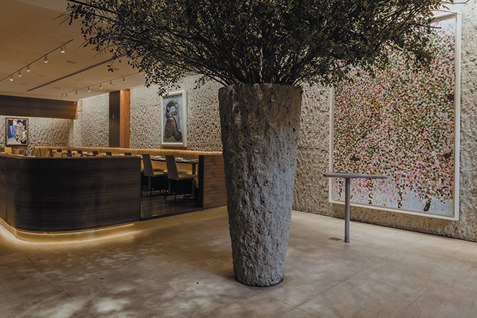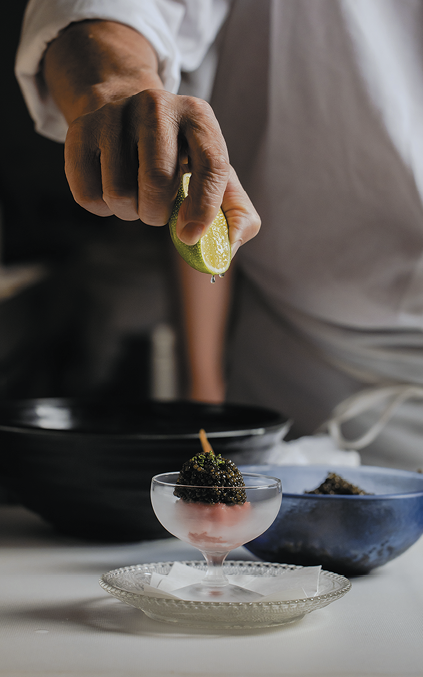- Home
- Media Kit
- MediaJet
- Current Issue
- Past Issues
- Ad Specs-Submission
- Reprints (PDF)
- Photo Specifications (PDF)
- Contact Us
- PRIVACY POLICY
- TERMS OF USE
![]()
ONLINE
![]()
ONLINE

The Masa Way
Editors’ Note
Masayoshi Takayama’s appreciation for food started at a young age, growing up working for his family’s fish market in a town of Tochigi Prefecture, Japan. From his early years of delivering fresh sashimi to neighbors on his bicycle, to prepping and grilling hundreds of fish courses to cater weddings in high school, his relationship with food has always been a way of life. Chef Masa is also chef/owner of Bar Masa (located next door to Masa), and is the chef at Kappo Masa (located at 976 Madison Avenue) in partnership with famed art gallerist Larry Gagosian. Chef Masa’s newest venture, Sushi by Masa located in Harrods in London, was opened in 2023.
Restaurant Brief
Refined beauty that isn’t affected by time or social changes. Shibui is never complicated or contrived. Purity of being, of living, of sensing is inherent in all elements of the Masa (masanyc.com) experience. The sushi counter made of a solid piece of Hinoki, Japanese Cypress, is sanded daily to a soft, porous state providing both visual and sensual satisfaction the moment one enters. The branches of seasonal plants are arranged daily to highlight the beautiful imperfections mother nature produces, offering a unique perspective from all angles. The otherwise simple decor is intentionally sparse to act as a blank canvas on which the food will be allotted space to shine. The courses build on seasonal properties utilized only in their freshest most delicious state. Each dish is composed to ensure that the most basic, innate character of the ingredients persists. A fundamental respect of the distinctiveness, which is naturally occurring, is observed with each act of slicing, shaving, and sprinkling. The food is prepared quickly, and plated for guests as soon as ready to preserve the idea that each dish is still in a living, being state. In essence, with essence, is essence – Masa is shibui.

Bar Masa
Where did you develop your appreciation for food?
I developed my appreciation for food in the home. My mother was the main cook for our family, but my parents owned a fish market and catering business so often my father would go to Tsukiji Market in Tokyo and come home with my favorites like clam and Uni. All five siblings would sit at a table with my mother and father and watch them make sushi for us. This gave us such great memories because I remember how much fun we had and the camaraderie of the family.
Did you know at an early age that you wanted to pursue a career as a chef?
When I was young, every kid was helping out in their family business. No one was forced to do it, but it was assumed you would help your parents. I don’t know what impact working in a fish shop had on my career because at the time it was just something I did. It was only after high school when I was studying at university that I started thinking about my career. At first, I thought I would be a doctor, but by the second year, I changed my mind and my brother took me to Tokyo and introduced me to the restaurant where I would end up working for so long. My brother was a chef, so I think it just made sense to see how restaurants worked.

Kappo Masa
What was your vison for creating Masa and how do you describe the Masa experience?
In California, I was able to have my own restaurant for the very first time after leaving my apprenticeship and time in Tokyo. I first opened Saba Ya, then Ginza (which later moved to Beverly Hills). What some people don’t know is I also opened a wine bar across the street from the first location of Ginza, called California Vine House. It had this oval counter where I served wine from the Napa Valley and grilled foods. It was there for a year or year and a half, but I think the concept was still too new for people at the time. This is all to say that when Chef Thomas Keller approached me to open a restaurant in New York, I knew it was time for a change.
I approached the opening of Masa the same way I approached opening Ginza in Los Angeles. The style and flavor of Japanese food was more American because I was working with the palates of the guests who were used to stronger flavors. That’s when I created the Toro Caviar dish – the mix of fat from the tuna and the saltiness of the caviar is something we never would have done in Tokyo, but for the American palate, it really worked.
The Masa experience is really about the Japanese idiom Ichi-go ichi-e, which is the concept of the unrepeatable nature of a moment. Every season highlights a different fish and every season we want people to have a unique experience. I like to have people enjoying the meal when they come and it’s the intimacy they have with the chef that makes it. I always write down what each guest had and we keep a file that goes back to when we opened in 2004. The next time the guest comes in, we go back to their previous menu and make sure it’s never the same. But it doesn’t only go one way – maybe the first time, but each visit you can talk to the customer, get to know them, and then develop the menu to their tastes and likes.

Toro Tartare with Osetra Caviar
What have been the keys to Masa’s leadership in the industry?
I’m not going to do trendy stuff. The only thing that is comfortable to me is enjoying real good food. I don’t follow fads and I am always trying to make dishes a little better and better. The ingredients we use can be manipulated in so many ways. I love the versatility of tuna, that it can be in a salad, grilled, as sushi or a roll. And Uni – of course, delicious in its purest form but also can be a sauce, roasted, steamed, or even stewed.
One of our most popular dishes is the Uni papaya, a dish that definitely doesn’t seem like it would be a natural pairing, but it works so beautifully. We use Hawaiian papaya and then make a uni sauce and roast them together and it’s incredible. The sweet against the brine is just perfect. That dish came together as I was traveling, and back in New York I kept working on it until it reminded me of that papaya I ate. I like to create dishes based on my food memories.
For me, I don’t like the idea of making a cookbook – after a year or even ten years – a written down recipe is dead to me. Food is always changing like the generations change and I want to keep changing the Masa experience. It’s the way I like to keep up.
How did Kappo Masa and your partnership with Larry Gagosian develop?
Larry is very charming, and he has a very strict, sharp eye. He can tell immediately if something is good or not and he has good taste. So when Ron Lauder came to my restaurant in Beverly Hills and brought Larry, it started a friendship and we decided to form a partnership in 2013 for Kappo. The one thing he disagreed with me about was opening the restaurant on the basement level. He said no restaurant has ever been successful in the basement, but I knew it would create a bit of mystery and privacy for our customers. And soon, he told me I was right.
I like working with him because he respects me as an artist and I find it very comfortable to work with him.
Will you discuss the opening of Sushi by Masa in Harrods in London and what guests may expect from this new offering?
Harrods came to us because they wanted to showcase a premiere chef in their dining hall space. At first I wanted a stand-alone restaurant, but once I visited the space and saw the energy and history of the room, I knew that’s where we wanted to have our location. It’s a 40-seat oval space that is right in the center of the dining hall and inside we have all the chefs slicing fish, plating dishes, and engaging with the customers, which is what I wanted to bring to the London market. Sushi by Masa really isn’t trying to replicate what we have in New York – it really is about introducing the London market to the Masa flavor and allowing the guest to have a fun and memorable experience in such a historic place.
.png)
Ohmi Beef Tataki with Shaved Truffles
How important has it been to build the Masa team, and will you highlight the talent and expertise of your team?
When it comes to hiring people, I’m always looking for, not talent, but who they are. In the food industry, personality is very important. If one’s personality is not good enough, one cannot make good food. I believe that talent is from the inside of a person’s spirit and heart. Personality is very important. Personality creates lots of great stuff. Those people care about the customer and their fellow workers, and that’s the kind of team I try to build up.
You enjoy being in the kitchen and creating dishes. How do you balance your time being a chef with the pressures of running a business?
I don’t feel any pressure. I’m very much enjoying the everyday as long as my team is doing things right. What is right to me? Working properly, cleanly, and making sure the ingredients are handled well. That’s always my first priority – clean. If the procedures I set in place are not being followed, I’m upset.
What advice do you offer to young people interested in pursuing a career as a chef?
Don’t think to grow too fast – every single day is ordinary stuff but it’s years later you will see how you grow. Today, there is so much information from YouTube and social media, and young people get confused about whether what they are doing is right. Am I in fashion? Am I trendy? If you follow the trend, you’re going to get mixed up. You have to have strong conviction and a point of view – believe in yourself and what you do. You must be confident every step to get more confident.
Masa has received many awards and accolades since its opening. Do you take time to reflect and appreciate what you have accomplished?
I always want to be better and better and look forward. I don’t want to stay the same all the time – I always want to be moving and doing something different. Otherwise, I get bored. Every day I am at the restaurant thinking of how I can change or improve something. What if we cut the fish this way, salt differently, or change a sauce? I have worked on our soy sauce until I made a clear sauce – it’s also gluten free. This one isn’t covered in soy sauce flavor that only shows the saltiness – it’s lighter and customers can taste the ingredients. This is what I mean – I didn’t like the dark color of our soy sauce, so I found a way to create clear and better sauce. It’s the constant evolution that I always strive for in my business and restaurant. ![]()